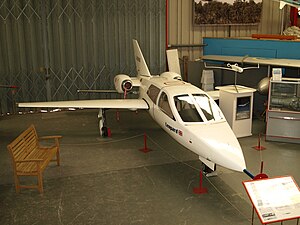CMC Leopard
| Leopard | |
|---|---|

| |
| CMC Leopard G-BRNM on display at the Midland Air Museum | |
| Role | Business jet |
| Manufacturer | Chichester-Miles Consultants |
| Designer | Ian Chichester-Miles |
| First flight | 12 December 1988 |
| Status | Project cancelled, both aircraft withdrawn from use |
| Number built | 2 |
The CMC Leopard was a British light personal business jet developed in the 1980s. Two prototypes were built and flown, but the type was never put into production.
Design and development
The Leopard was a twin-jet, mid-wing monoplane of composite construction with all-swept flying surfaces and jet fighter-like styling, apart from the podded engines, mounted on each side of the rear fuselage. The entire canopy hinged forward to allow access to the four reclining seats.[1]
A mockup was completed in 1982, leading to a prototype (registration G-BKRL[2]) built by the Designability company. The prototype first flew late in 1988. Development suffered a major setback when the engine manufacturer, Noel Penny Turbines, ceased business, leading to the grounding of the prototype. A second, refined prototype (registration G-BRNM[3]) was then constructed to use Williams International turbofans. This aircraft also incorporated a pressurised cabin, revised undercarriage, and a generally strengthened airframe. This second prototype was unveiled at the 1996 Farnborough International Airshow and first flew on 9 April 1997.
The project never progressed beyond the two aircraft built, later redesignated Leopard Four to distinguish them from a six-seat variant proposed in 2001, the Leopard Six. The EJ22 engine could no longer be used due to exclusive deal between Williams and Eclipse,[4] resulting in the Six being proposed to make use of the larger FJ33. Chief aircraft designer and CMC chairman Ian Chichester-Miles died in 2009, bringing the enterprise to an end.[5]
Aircraft on display

Until 2007, both prototype Leopards, G-BKRL and G-BRNM, were on display at the Bournemouth Aviation Museum. With the museum temporary closure and relocation in 2008, only the former was retained and moved to the new site, while G-BRNM was acquired by the Midland Air Museum at Coventry Airport.[6][7]
Specifications (second prototype)
General characteristics
- Crew: One pilot
- Capacity: 3 passengers
- Length: 24 ft 9 in (7.54 m)
- Wingspan: 23 ft 6 in (7.16 m)
- Height: 6 ft 9 in (2.06 m)
- Wing area: 63 sq ft (5.85 m2)
- Powerplant: 2 × Williams FJX-1 , 700 lbf (3.1 kN) thrust each
Performance
- Maximum speed: 540 mph (869 km/h, 470 kn)
- Range: 1,726 mi (2,778 km, 1,500 nmi)
- Service ceiling: 55,000 ft (16,765 m)
- Rate of climb: 6,340 ft/min (32.7 m/s)
References
- ^ "Leopard ready to leap", Flight International, p. 21, 6 September 1986
- ^ "G-INFO Database". Civil Aviation Authority.
- ^ "G-INFO Database". Civil Aviation Authority.
- ^ Sarsfield, Kate (20 March 2001). "Chichester Miles spots new market for Leopard Six jet". Flight International. Flightglobal. Retrieved 27 March 2016.
- ^ "Obituaries - Ian Chichester-Miles: aircraft designer". The Times. Times Newspapers. 15 October 2009. Retrieved 27 March 2016.
- ^ "Chichester-Miles Leopard G-BKRL". Bournemouth Aviation Museum. Retrieved 28 March 2016.
- ^ "Latest News". Midland Air Museum. 12 April 2008. Retrieved 28 March 2016.
- Taylor, Michael J. H. (1989). Jane's Encyclopedia of Aviation. London: Studio Editions. p. 922.
- World Aircraft Information Files. London: Bright Star Publishing. pp. File 891 Sheet 27.
